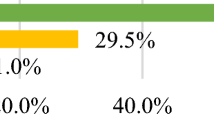Abstract
The purpose of this essay is to review and evaluate chapters in Fan and Cherry’s Sex Robots: Social Impact and the Future of Human Relations. In this edited volume, the authors of the various chapters present dialogues from the East and West to explore the social and cultural implications of sex robots. They also discuss whether sex robots have a positive, negative, or neutral impact on society and human relationships. This essay examines the key ideas presented in the book’s chapters, evaluates their arguments, and identifies research directions for the ethics of sex robots in the future. Specifically, this essay provides a detailed analysis of certain schools of thought, including the capability approach, Confucianism and Daoism, and their relevance to the topic of sex robots.
Similar content being viewed by others
Notes
The purpose of this essay is to review and evaluate chapters in Fan and Cherry (2021).
For example, imagine that we cannot compare and rank between options A and B, but either A or B is better than C. In this case, it is an incomplete order because we cannot rank between options A and B. But we may still say that it is a partial order, i.e., choosing C is worse than choosing A or B. We do not have the optimal (i.e., the best) option because we do not know how to rank A and B. But it is still maximal (i.e., no worse than others) if we choose either A or B rather than C. For the technical meanings of maximality and optimality, see Sen (2017, p. 7). For further details of incomplete order of ranking, maximality, and optimality, see Nussbaum (2001, pp. 103–106) and Sen (2018, pp. 16–17).
For the mapping between each kind of robot and the relevant central capabilities, see Table 2.2, 2.3, and 2.5 and the explanations in Jecker’s chapter (pp. 30, 33, 37).
Evans mentions Star Trek as an example of how science-fiction may be relevant. For example, she discusses the human-robot relationships between other characters with Data, the android character in Star Trek: The Next Generation. One relevant point Evans does not discuss is that Data has a sexual encounter with another human character, Tasha Yar, in “The Naked Now” (Season 1 Episode 3). If we want to use science-fiction to discuss the ethics of sex robots, we should consider this example.
Also, as Fan (pp. 183–184) points out, from Western perspectives, the current scientific understanding of the human body (carbon-based) is that it may not be that essentially different from robots (silicon-based). This topic is also a potential debate between Daoism and the West (especially within science or science-fiction) on the ethics of sex robots.
References
Anderson, E. N., & Raphals, L. (2006). Daoism and animals. In P. Waldau, & K. C. Patton (Eds.), A communion of subjects: Animals in religion, science, and ethics (pp. 275–290). New York: Columbia University Press.
Beauchamp, T. L., & Childress, J. F. (2019). Principles of biomedical ethics (Eighth edition. ed.). Oxford: Oxford University Press.
Chan, B. S. B. (2019). East Asia: Challenges to political rights. In Jay Drydyk, & L. Keleher (Eds.), Routledge handbook of development ethics (pp. 382–386). New York: Routledge.
Cherry, M. J. (2021). Could you marry a sex robot? Shifting sexual norms and the transformation of the family. In Ruiping, Fan, & M. J. Cherry (Eds.), Sex robots: Social impact and the future of human relations (pp. 97–114). Cham, Switzerland: Springer.
Cherry, M. J., & Fan, R. (2021). Sex robots: A twenty-first century innovation in the culture wars. In Ruiping Fan, & M. J. Cherry (Eds.), Sex robots: Social impact and the future of human relations (pp. 3–21). Cham, Switzerland: Springer.
Evans, K. K. (2021). Sex Robots and views from nowhere: A commentary on Jecker, Howard and Sparrow, and Wang. In Ruiping Fan, & M. J. Cherry (Eds.), Sex robots: Social impact and the future of human relations (pp. 161–178). Cham, Switzerland: Springer.
Fan, R. (2021). Sex robots, marriage, health, procreation, and human image. In Ruiping, Fan, & M. J. Cherry (Eds.), Sex robots: Social impact and the future of human relations (pp. 179–195). Cham, Switzerland: Springer.
Fan, R., & Cherry, M. J. (Eds.). (2021). Sex robots: Social impact and the future of human relations. Cham, Switzerland: Springer.
Howard, M., & Sparrow, R. (2021). Nudge nudge, wink wink: Sex robots as social influencers. In Ruiping Fan, & M. J. Cherry (Eds.), Sex robots: Social impact and the future of human relations (pp. 57–74). Cham, Switzerland: Springer.
Jecker, N. S. (2021). Sociable robots for later life: carebots, friendbots and sexbots. In Ruiping, Fan, & M. J. Cherry (Eds.), Sex robots: Social impact and the future of human relations (pp. 25–40). Cham, Switzerland: Springer.
Kleeman, J. (2021). Sex robots & vegan meat: Adventures at the frontier of birth, food, sex & death. London: Picador.
Lee, J. (2017). Sex robots: The future of desire. Cham, Switzerland: Palgrave Macmillan.
Mayor, A. (2018). Gods and robots: Myths, machines, and ancient dreams of technology. Princeton: Princeton University Press.
Nussbaum, M. (1995). Objectification. Philosophy and Public Affairs, 24(4), 249–291.
Nussbaum, M. (1999). Sex & social justice. New York: Oxford University Press.
Nussbaum, M. (2001). Comment. (Ed.), Goodness and advice (pp. 97–125). Princeton, N.J.: Princeton University Press. Amy Gutmann.
Nussbaum, M. (2005). Women’s bodies: Violence, security, capabilities. Journal of Human Development, 6(2), 167–183. https://doi.org/10.1080/14649880500120509
Nussbaum, M. (2006). Frontiers of justice: Disability, nationality, species membership. Cambridge, MA: Belknap Press of Harvard University Press.
Nussbaum, M. (2011). Creating capabilities: The human development approach. Cambridge, MA: Belknap Press of Harvard University Press.
Sen, A. (2017). Reason and justice: The optimal and the maximal. Philosophy, 92(1), 5–19. https://doi.org/10.1017/S0031819116000309
Sen, A. (2018). The importance of incompleteness. International Journal of Economic Theory, 14(1), 9–20. https://doi.org/10.1111/ijet.12145
Wang, J. (2021). Should we develop empathy for social robots? In R. Fan, & M. J. Cherry (Eds.), Sex robots: Social impact and the future of human relations (pp. 41–56). Cham, Switzerland: Springer.
Wildes, K. W. S. J. (2021). Sociable robots: Technology, automation, and human relationships in postmodern society. In Ruiping Fan, & M. J. Cherry (Eds.), Sex robots: Social impact and the future of human relations (pp. 145–160). Cham, Switzerland: Springer.
Xu, H. (2021). What kinds of use of sex robots can be morally allowed? A Confucian perspective. In Ruiping Fan, & M. J. Cherry (Eds.), Sex robots: Social impact and the future of human relations (pp. 129–142). Cham, Switzerland: Springer.
Yung, L. Y. Y. (2021). The moral significance of human likeness in sex robots: A Confucian perspective. In Ruiping, Fan, & M. J. Cherry (Eds.), Sex robots: Social impact and the future of human relations (pp. 115–128). Cham, Switzerland: Springer.
Zhang, E. Y. (2021). Why sex? Sex-bots from a Daoist perspective. In Ruiping, Fan, & M. J. Cherry (Eds.), Sex robots: Social impact and the future of human relations (pp. 77–96). Cham, Switzerland: Springer.
Author information
Authors and Affiliations
Corresponding author
Ethics declarations
Competing interest
This manuscript is not under consideration by any other journal. I declare that I have no competing financial interest.
Additional information
Publisher’s Note
Springer Nature remains neutral with regard to jurisdictional claims in published maps and institutional affiliations.
Rights and permissions
Springer Nature or its licensor (e.g. a society or other partner) holds exclusive rights to this article under a publishing agreement with the author(s) or other rightsholder(s); author self-archiving of the accepted manuscript version of this article is solely governed by the terms of such publishing agreement and applicable law.
About this article
Cite this article
Chan, B.S.B. East-West Dialogues on the Ethics of Sex Robots. HEC Forum (2023). https://doi.org/10.1007/s10730-023-09507-0
Accepted:
Published:
DOI: https://doi.org/10.1007/s10730-023-09507-0




